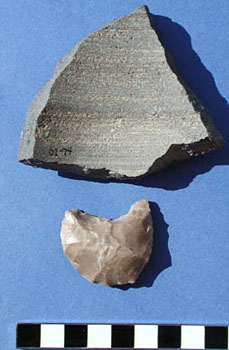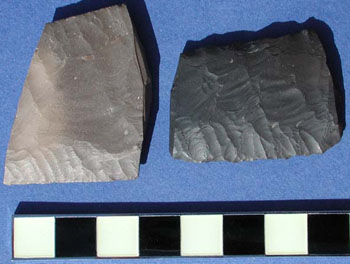 |
|
Stone vessel fragments found in the surface debris. One is carved in the form of a reed mat. It is made from limestone, the nearest source of which is over 30 miles away. The darker stones come from the Eastern Desert near the Red Sea.
|
|
A crescent drill used to manufacture the stone vessels was also recovered. This was hafted on the concave side to a stick and spun around to hollow out the interior of the stone vessel. The rills on the interior of the diorite vessel were made in this way. Sand was used as an abrasive. The only metal available in the predynastic period was copper, which was far too soft to make any impact on these very hard stones.
|  |
 |
Flint microdrills were used to perforate the beads; the one shown here is of carnelian. They were used in the same way as the crescent drills, hafted to a stick and spun around between the hands or using a bow.
|
 |
|
Fragments of fine bifacially knapped flint lances or knives. The micro-retouch at the edges is exquisite. Such lithics were made by specialist workers from tabular flint that also had to be imported into the areas. Debitage--the waste flakes from the manufacturing and sharpening of these knives--indicates that the specialists lived in Hierakonpolis.
|

